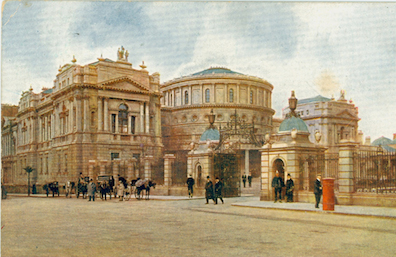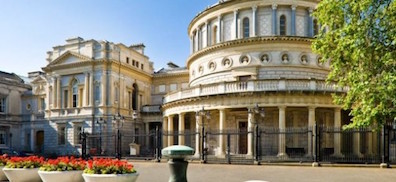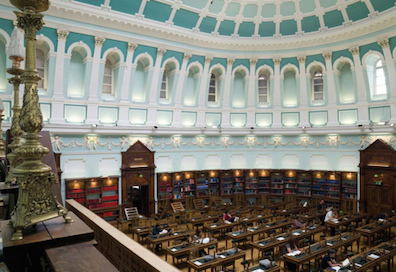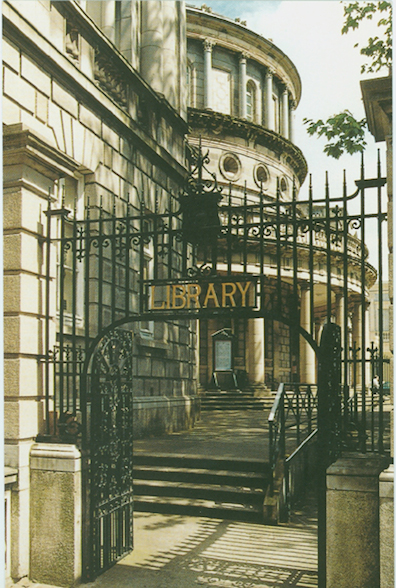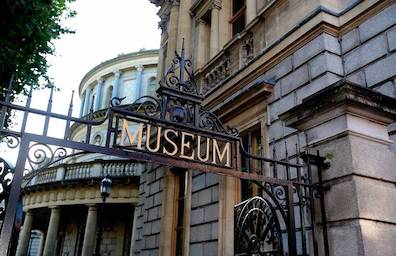In Telemachus, before Mulligan and Stephen discuss
the talk that Stephen will give there, Haines mentions his plan "to
visit your national library today." Gifford notes
that in the late 19th century the National Library was
associated with “efforts to preserve records and keep the Irish language and
culture alive,” which no doubt accounts for Haines'
pilgrimage there. Although Haines has
asked to hear “your idea of Hamlet,” he is not present
in the library when Stephen propounds it.
In Lestrygonians, thinking about the ad for
Alexander Keyes that he intends to model on an ad that ran
earlier, Bloom tells himself, "Must look up that ad in
the national library." Later in the same chapter,
he reminds himself again, this time thinking specifically of
the newspaper which ran the ad: "That Kilkenny
People in the national library now I must."
But when he heads in that direction at the end of the chapter,
he goes first to the National Museum on the other side of the
plaza: "Making for the museum gate with long windy
strides he lifted his eyes. Handsome building. Sir Thomas
Deane designed."
Two architects of this name designed the two buildings in the
1880s: Sir Thomas Newenham Deane and his son Sir Thomas Manly
Deane. (The father's father too, a third Sir Thomas Deane, was
an Irish architect who designed the Trinity College Museum
earlier in the century.) The buildings are grandly eclectic.
As Bloom looks at one of them (probably the Museum) he again
thinks approvingly of the architecture: "His eyes
beating looked steadfastly at cream curves of stone. Sir
Thomas Deane was the Greek architecture." Gifford
comments that Newenham Deane and Manly Deane "practiced in a
rather restrained and heavy way the 'Renaissance style' taught
and advocated by the École des Beaux Arts in Paris; while it
is technically incorrect to call this style 'Greek,' the
handling of columns and pediments is somewhat reminiscent of
Greek architecture."
Stephen's Shakespeare talk takes place in the office of the library's
director, Thomas Lyster. Partway through the talk, the
director's attention is called to the arrival of Bloom:
"— Mr Lyster, an attendant said from the door ajar . . .
There's a gentleman here, sir, the attendant said, coming
forward and offering a card. From the Freeman. He
wants to see the files of the Kilkenny People for
last year." As Lyster busies off to help Bloom find his way to
the newspapers, Buck Mulligan, who has arrived in the library
not much earlier, snatches up the calling
card Bloom has presented to the attendant and says, "I
found him over in the museum where I went to hail the
foamborn Aphrodite." Lyster oversaw a staff of 15 who helped
patrons find what they were looking for in the entirely
noncirculating collection of library holdings. As Hugh Kenner
notes in his foreword to Joseph O'Brien's Dear, Dirty
Dublin (1982), these employees were kept busy serving a
very large number of patrons, most of them college students.
Near the end of Scylla and Charybdis, Stephen
follows Mulligan out of the office, through "The
constant readers' room" (the grand showpiece of the
building's interior), past "The turnstile,"
down a staircase, and into "The pillared Moorish hall,
shadows entwined." The men are now in the
ground-floor entrance hall, a beautiful blue and white room
whose Corinthian columns echo the columns on the building's
exterior. It cannot be called Moorish in any strict sense, but
does have an exotic otherworldly flavor that apparently
appeals to Stephen's fascination
with things Islamic. At the door, as he is about to
leave the building, Stephen stands aside to let an unnamed
man, Bloom, pass between himself and Mulligan, and he thinks,
"The portico. / Here I watched the birds for augury."
The portico is a semicircular covered porch with stone steps
leading down to the Kildare Street sidewalk.
In section 5 of A Portrait of the Artist as a Young Man,
Stephen stood on the portico steps and watched the birds in
the sky the way ancient Roman augurs did: "What birds were
they? He stood on the steps of the library to look at them,
leaning wearily on his ashplant.
They flew round and round the jutting shoulder of a house in
Molesworth Street. . . . They were flying high and low but
ever round and round in straight and curving lines and ever
flying from left to right, circling about a temple of air. . .
. Why was he gazing upwards from the steps of the porch,
hearing their shrill twofold cry, watching their flight? For
an augury of good or evil? . . . And for ages men had gazed
upward as he was gazing at birds in flight. The colonnade
above him made him think vaguely of an ancient temple and the
ashplant on which he leaned wearily of the curved stick of an
augur."
Fargnoli and Gillespie note that "In Joyce's time the
National Library served as a gathering place for students from
University College, Dublin (at that time located just south of
the library across St Stephen's Green), and a number of
episodes in the fifth chapter of A Portrait of the Artist
as a Young Man are set at and around the library."
As Mulligan and Stephen stand on the portico, they see
Bloom's "dark back" go before them, step of a pard, down,
out by the gateway, under portcullis barbs." This
is the ironwork gate, marked "Library" in gilt letters and
topped with spikes, that leads out to Kildare Street. Bloom
has entered its "Museum" counterpart at the end of Lestrygonians.
The near-meeting of the two protagonists in the library is
retrospectively acknowledged in Ithaca, when Bloom
and Stephen make tentative plans to meet again to continue
their conversation. One of the many places proposed for such
future meetings is "the National Library of Ireland,
10 Kildare street." Later in Ithaca,
Bloom again recalls his "visit to museum and national
library" earlier in the day.
